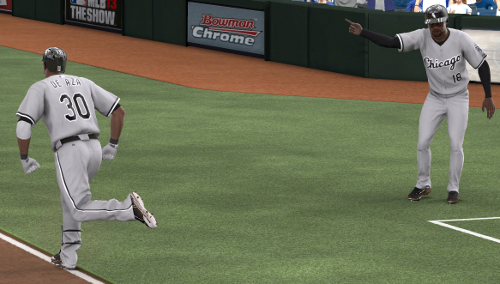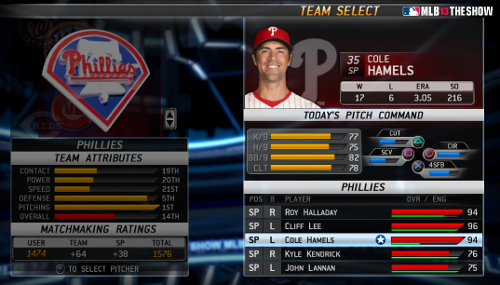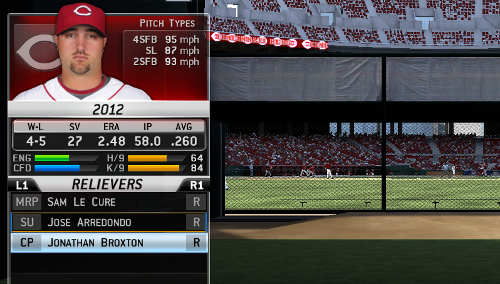Online Play Takes Tremendous Step Forward in MLB 13: The Show

Online play has forever been the Achilles’ heel of the MLB: The Show series representing the worst sports gaming has had to offer in that area. When NBA 2K made strides last year it left The Show as the only sports franchise that was not providing an acceptable online experience. Regardless of the reasons why, online performance was typically awful, and the games were simply not fun to play due to the advantage held by the pitchers.
Based on the days following release of MLB 13: The Show it has become clear that exceptional progress has been made. There are four primary reasons for the vastly improved online experience beyond just the seemingly more stable and consistent performance.
Personal experience so far involves having played online games on four of the five days that The Show has now been out. First impressions, which have always been poor in the past, were much more encouraging this time around. Several others who have long lamented The Show’s online play have shared similar findings with me, and reports throughout various communities seem to confirm it as well.
In terms of how the games have run they’ve been almost completely lag free and responsive. There have been occasional hiccups, such as hitches while the ball is traveling to the plate, but those occurrences have been relatively low. Performance of course can vary but there is no question that as a whole games are more often smooth and issue free than ever before.
A number of excellent design decisions were made that have improved the overall online experience. Though they come maybe a few years later than they should have there is no discounting their impact now.

Opened Hitting Timing Window
The effects seem to be even more pronounced online than offline vs the CPU. With previous iterations online games amounted to pitching duels which weren’t even based on skill. Hitters were relegated to essentially guessing and hoping they got lucky and hit a home run. There was practically no way to play station-to-station baseball successfully. The result was low scoring games dominated by strikouts that were completely frustrating and unenjoyable.
The variety of games seen online now though has been practically ideal. I’ve had games with scores like 6-5, 10-3, 5-1, and 3-2. Adding to that the hit numbers are far more realistic. In those games mentioned teams have produced between 7 and 16 hits. My batting average is now .273, over 100 points more than it was with MLB 12. Falling behind by a run, or even more, no longer makes it feel as if the game is effectively over.
Carry Over of Pitcher Fatigue
Finally a baseball game has implemented a way to prevent the overuse of #1 starters and even the best pitchers out of the bullpen. The incredibly tough hitting environment for The Show in the past was exacerbated by everyone taking the best teams and only using the top of the rotation pitchers. It was bad enough that the lag and jarring framerate loss made timing hits effectively and consistently near impossible, but good luck doing that every time against a Justin Verlander or Felix Hernandez.
New for MLB 13: The Show is that “Pitcher Energy” now plays a factor. Use a #1 starter in one game, and in the next his energy bar will be depleted based on how much work he had put in. Use a closer for two innings and it will probably be best not to use him in the next game. There is an element of strategy to be used here that managers in real life have to consider and now those who play online have to as well.
One concern was that the energy would not deplete enough to dissuade people from continuing to overuse certain pitchers. Thankfully it doesn’t look like they’ll be able to as it really has shown to play a factor. As an experiment I used the #1 starter in two straight games. In the first game he went 7 1/3, and in the second game I was lucky to get him through 3 innings and even then he was not very effective at that energy level. Relievers are a little tougher to judge but again overusing anyone there will be a mistake. Remember this carries over no matter what team is used from game-to-game.
New Matchmaking System
The matchmaking now attempts to better place opponents with similar skill level, teams used, and staring pitchers. No one sees what team or pitcher the opponent will be using until the connection has been made and can’t be backed out of. That is good in that people won’t avoid facing someone for their record or who they are using, but one downside is not being able to see the other pitcher means you’re unable to adjust your lineup/batting order accordingly.
So far the system appears to be doing an okay job. There has been some imbalance, taking the Mariners and getting stuck up against the Braves doesn’t seem completely fair, but there have been no hugely outmatched sides in a pairing seen so far.
Changes to Guess Pitch System
One of the most frustrating things to come up against online has been an opponent who uses the “Guess Pitch” feature incessantly. The most common tactic was to guess fastball every time. Doing so would indicate to them in many cases what to expect before the pitch even was released. If the indication flashed, they would be able to prepare for the fastball, and if not they could probably then sit on it being off-speed. Guessing right also took control after the first selection by the pitcher completely away which was exceedingly off-putting.
All this would cause someone like myself to throw fastballs only out of the zone which, being forced to change any personal strategies no matter what that may be, takes a lot of fun out of the battle. It was an artificial way to assist people in hitting rather relying on their own skill to pick up a pitch. At the same time it was hard to blame anyone for utilizing it since SCEA had the feature in and with how difficult it was to hit online any help was to be viewed as welcome.
Now though Guess Pitch is not overpowered. People have figured this out because in all the games played I’ve only faced one person who seemed to be using it at all, and indication of a correct guess was only seen a few times throughout the game at that. The flash of red only appears now when the ball is halfway to the plate. Anyone trying to guess both pitch type and location won’t see anything if they get one wrong.

Comparing the average statistics for the top 10 players on the leaderboards for MLB 13 to the early MLB 12 numbers highlights the drastic difference that has taken place.
AVG
MLB 12: .194
MLB 13: .314
R/G
MLB 12: 1.93
MLB 13: 4.91
ERA
MLB 12: .70
MLB 13: 2.03
WHIP
MLB 12: .53
MLB 13: .77
K/9
MLB 12: 13.0
MLB 13: 9.9
Only minor gripes now remain like the amount of pausing that has to be done over the course of a game – and the wait without ability to do anything while an opponent is making adjustments on their end. Opponents can also start their first pitch of an at-bat or inning too suddenly preventing any consideration of a pinch hitter or runner. Several times I’ve reached the pitcher in the batting order and by the time I realized that my opponent had (and seemingly on purpose) already started to throw the first pitch. Low pitches can still be abnormally hard to pick-up but after a bit I was able to adjust better to it than in the past. The new matchmaking system has resulted in a few instances where there was a wait to find an opponent, and the dreaded “Traffic Delay” has appeared before the start of a few games, but nothing egregious in regards to either.
MLB 13: The Show’s online play now offers more consistent performance, a new strategic nature, and a simply more fun experience. Performance has proven to be much improved and the design decisions very effective. It’s incredibly satisfying to finally have some positive vibes around online for The Show. Having finally pulled together the complete package The Show can now find itself a contender for Best Sports Game of the Year honors.
